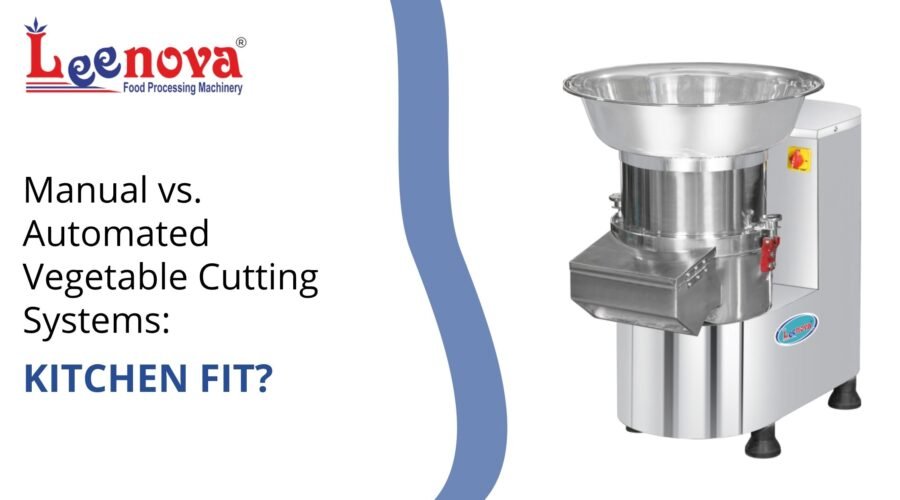Introduction
Commercial kitchens lose up to 30% of their prep time to manual cutting tasks, and most operators don’t realize it until labor costs spiral out of control. Whether you run a cloud kitchen, a hotel, or a catering business, choosing between manual and automated vegetable cutting systems determines your kitchen’s efficiency, consistency, and long-term profitability.
Manual systems offer control and low upfront cost. Automated systems deliver speed, precision, and scalability. But the real question isn’t which is better—it’s which fits your operation right now and where you’re headed in the next two years.
This post walks you through the core differences, operational realities, and decision factors for both systems. You’ll learn what each type handles best, where they fall short, and how to match the right system to your kitchen’s size, volume, and growth plan.
Types of Vegetable Cutting Systems
Manual Vegetable Cutting Systems
Manual systems include handheld choppers, mandolines, and bench-mounted slicers. They require operator force and control for every cut.
Key advantages:
- Low purchase cost (₹500–₹15,000)
- No power consumption
- Easy to clean and store
- Ideal for small batches and varied cuts
Limitations:
- Slower output (5–10 kg/hour depending on operator skill)
- Inconsistent sizing across batches
- Higher injury risk without proper technique
- Labor-intensive during peak hours
Automated Vegetable Cutting Systems
Automated systems range from semi-automatic table-top units to fully programmable floor machines. They use motorized blades, interchangeable discs, and preset cutting programs.
Key advantages:
- High throughput (50–200 kg/hour)
- Uniform cuts for better cooking consistency
- Reduced dependency on skilled labor
- Continuous operation during high-volume periods
Limitations:
- Higher upfront investment (₹30,000–₹3,00,000+)
- Requires electricity and periodic maintenance
- Learning curve for programming and blade changes
- Larger footprint in compact kitchens
Comparison: Manual vs. Automated Systems
Cost Analysis
Manual systems win on initial cost but lose on labor. An operator earning ₹15,000/month spends 2–3 hours daily on prep, costing you ₹90,000–₹1,35,000 annually just on cutting tasks.
Automated systems cost more upfront but cut prep time by 60–80%. A mid-range machine pays for itself in 8–14 months in a kitchen processing 40+ kg of vegetables daily.
Efficiency and Productivity
Manual systems process 5–10 kg per hour. Automated systems handle 50–200 kg per hour depending on the model.
The difference compounds during peak service. A manual operator prepping 50 kg of onions takes 5–7 hours. An automated system finishes in 30–45 minutes, freeing up labor for cooking and plating.
Consistency and Output Quality
Manual cutting produces irregular sizes, which leads to uneven cooking. Automated systems deliver uniform dimensions—critical for frying, roasting, and portion control.
Restaurants report 15–20% reduction in food waste after switching to automated cutters because consistent sizing improves yield and reduces trim loss.
Ease of Use and Safety
Manual systems require knife skills and physical stamina. Operator fatigue increases injury risk, especially during long shifts.
Automated systems need 15–30 minutes of training for basic operation. Safety guards, emergency stops, and enclosed cutting chambers reduce accidents by over 70% compared to manual prep.
Maintenance and Cleaning
Manual tools clean in 2–5 minutes under running water. Automated machines need 10–15 minutes for disassembly, blade cleaning, and reassembly after each shift.
However, automated systems eliminate sharpening and blade replacement costs common with manual tools. Most machines use stainless steel components designed for commercial dishwashers.
Choosing the Right System for Your Kitchen
Volume and Kitchen Size
If you process under 20 kg daily and operate in limited space, manual systems make sense.
If you handle 40+ kg daily or run multiple service periods, automated systems become non-negotiable for speed and consistency.
Budget and ROI Timeline
Manual systems suit startups and low-budget operations. Automated systems suit established kitchens ready to scale or reduce labor dependency.
Calculate your current labor cost per kg of prep. If it exceeds ₹8–₹10/kg, automation delivers ROI within the first year.
Staff Skill and Turnover
High-turnover kitchens benefit from automated systems because they reduce training time and minimize the impact of losing skilled prep staff.
Manual systems work better when you have experienced operators who value control over speed.
FAQs
Can automated systems handle delicate vegetables like tomatoes and leafy greens?
Yes, most automated cutters come with adjustable blade speed and pressure settings. You swap in specialized discs for soft vegetables to prevent crushing.
How often do automated machines need blade replacement?
Blades last 6–12 months in high-volume kitchens. Stainless steel blades resist corrosion and maintain sharpness longer than manual knife edges.
Do automated cutters work for frozen vegetables?
Not directly. Most machines require thawed or semi-thawed vegetables to avoid motor strain and blade damage. Some industrial models handle frozen products but cost significantly more.
Can I get different cut shapes from one machine?
Yes. Automated systems use interchangeable cutting discs for dicing, slicing, julienne, shredding, and crinkle cuts. You switch discs in under 2 minutes.
Conclusion
Manual systems fit small kitchens with low volumes and tight budgets. Automated systems suit growing operations that need speed, consistency, and labor efficiency.
Evaluate your daily prep volume, calculate your labor cost per kg, and project your growth over the next 12–24 months. That’s your decision framework.
Leenova Kitchen Equipments designs and supplies vegetable cutting systems built for Indian commercial kitchens—compact, durable, and backed by local service support. Whether you’re starting small or scaling fast, we match the right system to your kitchen’s real needs, not a sales pitch.
Explore our range at leenovakitchenequipments.com or call us for a free kitchen efficiency assessment. Let’s cut prep time, not corners.


